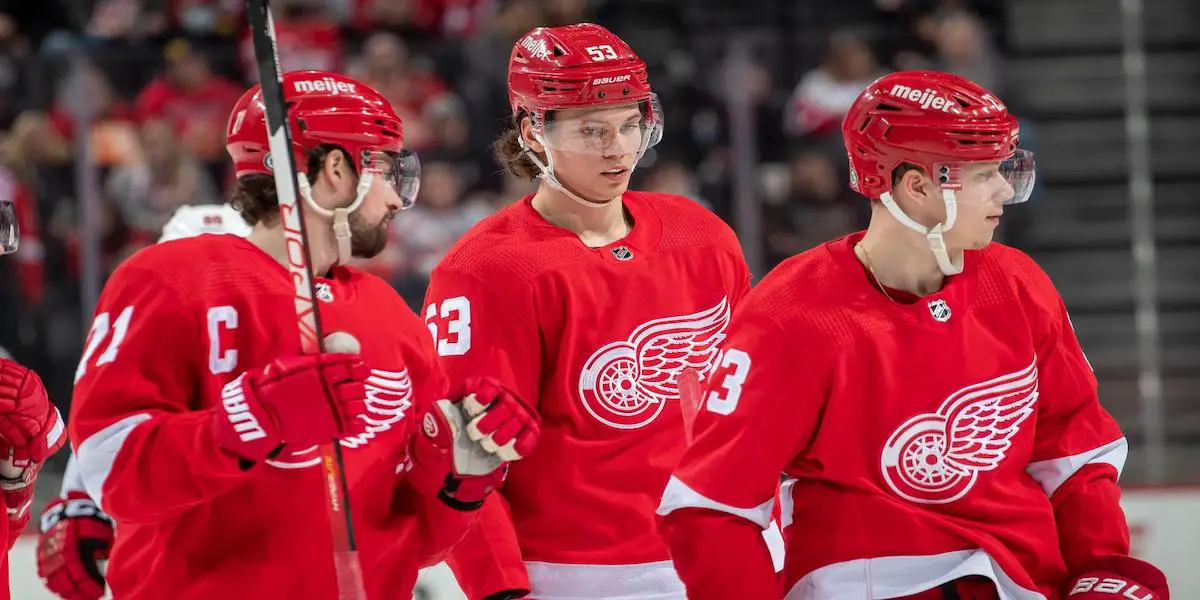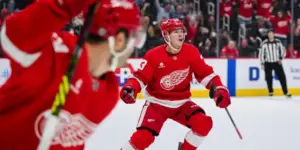
With a busy free agency period signing big-name players such as Andrew Copp, Ben Chiarot, and David Perron, the 2022-23 Detroit Red Wings now have expectations and are heading into a new season for the first time in this rebuild. With those new names, Detroit saw career years from Dylan Larkin and Tyler Bertuzzi, who have been the core of the team the past few seasons.
The first two top ten draft selections by Steve Yzerman in Detroit made their mark in the NHL last season and look to be on their way to becoming stars in the league; and could have another top prospect in the lineup in the lineup Simon Edvinsson. With many new faces through free agency and prospects making the jump to the pro level mixed in with Detroit’s young core, newly appointed head coach Derek Lalonde’s first Red Wings camp is shaping up to be highly competitive and full of excitement. Here are eight questions surrounding the Red Wings heading into the 2022-23 season.
What will year two of Seider and Raymond look like?
There are plenty of examples in the NHL where a young player has a stellar first season but falls into the dreaded “Sophmore slump.” Seider and Raymond both have well-exceeded expectations at this point in their young careers by changing the timeline of the Red Wings’ rebuild and becoming two of the team’s best players after one season. This season, both players are well-positioned to take another step forward and cement themselves as cornerstone pieces in Detroit.
After winning the Calder Memorial Trophy last season, Seider will be looking to solidify himself as one of the league’s most prominent defensemen. With the additions of Ben Chiarot and Olli Maatta, Seider will have a capable partner on his left side, potentially leading to more growth in year two.
While Raymond slowed down production-wise in the second half of last season, it was the most amount of hockey he has played in his professional career at only 19 years old. Raymond became acclimated so quickly by playing with Tyler Bertuzzi and Dylan Larkin for most of last season, which helped his production. With the signings of Copp, Perron, and Kubalik, could Lalonde mix things up and see how Raymond handles being the go-to guy on his own line?
How will Andrew Copp handle the 2C role?
The Ann Arbor native celebrated a breakout season for himself, scoring 21 goals and 32 assists in 72 games, split between the Jets and the Rangers. Copp found his offensive side upon arriving in New York, where he was trusted into a top-six role, playing alongside Artemi Panarin and scoring at a near point-per-game pace with 32 points in 36 games, combining both his regular and post-season totals.
Copp was rewarded a five-year, $28,125,000 contract ($5.625 AAV) from the Red Wings within the first hour of the free agency opening. In his post-free agency media availability, Yzerman praised Copp’s versatility but ultimately viewed him as a solution to the Red Wings’ second-line center need.
While Copp broke out offensively during the 2021-22 season, he primarily did it on the wing, only spot filling the middle when needed. In years past, Copp had been deployed mainly in a shutdown, third-line role alongside Adam Lowry and was quite effective defensively. Copp is also strong in the faceoff circle, averaging over 53% the past two seasons. In both Winnipeg and New York, Copp was often one of the go-to players on the penalty kill and was 13th in the NHL among forwards in average short-handed time on ice per game at 2:15.
With his defensive capabilities and having many winger options to potentially line up with, Copp should see success in his new and increased role in Detroit.
Jakub Vrana break out season?
Upon being traded to Detroit at the 2021 NHL trade deadline, Vrana made a quick impression, scoring eight goals and 11 points in 11 games. It felt that the 2021-22 season was supposed to be Jakub Vrana’s breakout year before it was announced that the 26-year-old would require shoulder surgery and miss the first half.
Vrana would return to the Red Wings lineup in March and looked like he hadn’t lost a step, scoring 13 goals and adding six assists in 26 games. Barring any injury, Vrana is coming into training camp fully healthy and motivated to be a go-to scorer. Under a new head coach in Derek Lalonde, we will also likely see Vrana get more opportunities in the lineup.
From Dobber, Vrana’s most common linemates last season were Sam Gagner, Joe Veleno, Pius Suter, and Filip Zadina. While Vrana still produced at a high rate with those players, it is easy to see a reality where Vrana can produce more with higher-skilled players. Playing alongside either Dylan Larkin or Andrew Copp to start the season could allow Vrana to finally reach the 30-plus goal potential he has shown since he arrived in Detroit.
Will Simon Edvinsson make the opening night lineup?
It took the fellow sixth overall pick, Moritz Seider, two years to make his NHL debut, primarily due to the uncertainty surrounding professional hockey in North America in 2020. Can Edvinsson do it after only one-year post-draft?
Edvinsson was heavily relied upon last season for Frolunda, averaging over 20 minutes a game, scoring two goals and 17 assists in 44 games. Edvinsson also won the EliteProspects award for the best junior-aged player in the SHL. At 6 foot 6, 210 pounds, Edvinsson would be the biggest defender on Detroit’s blueline. Add that with his skating ability and defensive stick, and Edvinsson could bring the most upside over any other Red Wings’ defenseman not named Moritz Seider.
Detroit’s top-four to start the season feels all but confirmed with some combination of Moritz Seider, Ben Chiarot, Filip Hronek, and Olli Maatta. With injuries to Jake Walman and newcomer Mark Pysyk, the bottom pair is for the taking. Edvinsson will compete against the likes of Robert Hagg, Jordan Oesterle, Gustav Lindstrom, and Steven Kampfer.
When asked about Edvinsson’s preparedness for the NHL, Steve Yzerman is not opposed to starting the team’s top prospect in the NHL.
“We’re optimistic. We’ll give him [Edvinsson] an opportunity, and if he’s ready to play and can play a regular role, that’d be great for us.”
Will Kubalik bounce back?
After dominating the Czech and Swiss pro leagues in his early 20s, Kubalik burst into the NHL, scoring 30 goals and 46 points as a 24-year-old rookie. Three summers later, Kubalik went unqualified by Chicago after a lackluster third season, which led him into unrestricted free agency, eventually signing a two-year contract with an average annual value of $2.5 million.
Kubalik wasn’t the only Chicago player to struggle to produce. Most forwards not named Patrick Kane and Alex Debrincat had down seasons, leading to Chicago being lower in the standings. Kubalik plays a perimeter style that, when distributed, the puck can score on any shot. In his rookie season, where he found his most success, Kubalik’s most common linemates were Jonathan Toews, Drake Caggulia, and Brandon Saad. This past year, his most common linemates were Kirby Dach and Phillip Kurashev, both players who also had down years.
In his first two seasons, Kubalik was on pace to score 55 points in a full 82-game season, compared to his 34-point pace in 2021-22. He will potentially have plenty of talent to play alongside in Detroit and should see an uptick from last season’s totals.
Larkin and Bertuzzi extensions?
Possibly the biggest question surrounding Detroit heading into the new season. If it weren’t for injury, Dylan Larkin would have likely seen career highs in every offensive category, finishing with 31 goals and 69 points in 71 games. Tyler Bertuzzi scored nearly a point-per-game pace throughout the season, scoring 30 goals and 62 points in 68 games. Both Larkin and Bertuzzi are in the final years of their contracts, and both players are in line for hefty raises.
It was reported earlier this summer by Sportsnet’s Elliotte Friedman that Detroit and Larkin were believed to be working towards an extension. After the recent flurry of long-term extensions for young, top-level centers, Larkin’s ask has likely gone up. He also switched agencies from Kurt Overhardt and KO Sports to CAA, represented by Matt Williams and Pat Brisson. In his past two contract negotiations, Bertuzzi and Detroit have settled on one and two-year deals.
Both players are integral pieces to the team’s core, and Steve Yzerman previously stated this summer that his goal was to extend both Larkin and Bertuzzi long-term. At this point, it feels as if both players will be re-signed long-term before this season is over.
Who will slot in as 3C?
There will be competition for who slots in behind Dylan Larkin and Andrew Copp. The likeliest seems to be Pius Suter, who was primarily deployed as Detroit’s second-line center last season. The 26-year-old was signed to a two-year contract after going unqualified by Chicago, scoring 15 goals and 21 assists in 82 games. Suter was also one of Detroit’s top penalty killers, ending the team’s short-handed goal drought.
Then there are the two younger options, Michael Rasmussen and Joe Veleno.
Starting with Rasmussen, the 23-year-old had a rocky first half last season but found his game in the new year, finishing with 15 goals and 27 points in 80 games. Rasmussen spent the large portion of last season as the third-line center, and with his size (6 foot 6, 230 pounds) and strong finish, he could be the guy.
Veleno, 22, spent most of last season at the NHL level but was deployed as the fourth-line center. In 66 games played, Veleno scored eight goals and 15 points, which is underwhelming. In Veleno’s defense, he had limited ice-time and was playing with less-skilled players, which is an adjustment for a recent first-round pick. Veleno will need a strong camp and preseason to overtake either Suter or Rasmussen.
How much will Lalonde’s system improve Detroit’s team defense?
Detroit will have a new voice behind the bench in Derek Lalonde for the first time in seven seasons. Every stop the first-time NHL head coach has been at, he has been praised for his open communication skills and defensive structure.
Detroit has a lot to improve on defensively as they finished 31st in goals against last season, only beating out the Montreal Canadiens, who allowed 317. When joining Tampa Bay as an assistant in 2018, Lalonde was tasked with helping instill more defensive responsibility into a high-octane offensive team. In the four years Lalonde was in Tampa Bay; the team finished top ten in the NHL in goals against every season.
There is also the issue of the penalty kill, which finished 32nd in the NHL with a dismal 73.8%. Lalonde was also the man in charge of Tampa Bay’s penalty kill over the past four seasons, which was near the top of the league, but he won’t be the only defensive mind on Detroit’s bench. The Red Wings also hired Bob Boughner and Jay Varady; both have coached successful penalty kills in the NHL. Last season, the San Jose Sharks finished second in the NHL with an 85.2% penalty kill success rate under Boughner and Varady helped the Coyotes finish 11th in 2021.
With the additions of Ben Chiarot, Olli Maatta, Robert Hagg, and potentially Simon Edvinsson on the back end and two defensive forwards in Andrew Copp and David Perron, Lalonde will have more to work with on Detroit’s roster compared to years past.
Discover more from Inside The Rink
Subscribe to get the latest posts sent to your email.



